
Vamana also known as Trivikrama, Urukrama, Upendra, Dadhivamana, and Balibandhana, is an avatar of the Hindu deity Vishnu. He is the fifth avatar of Vishnu and the first Dashavatara in the Treta Yuga, after Narasimha.
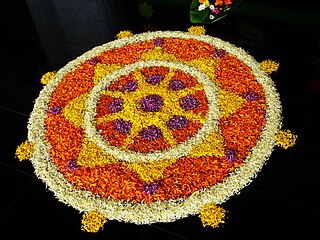
Onam is an annual harvest and Hindu cultural festival celebrated mostly by the people of Kerala. A major annual event for Keralites, it is the official festival of the state and includes a spectrum of cultural events.

Mahabali, also known as Bali, Indrasenan, or Māveli, is a daitya king featured in Hinduism. He is the grandson of Prahlada, and a descendant of the sage Kashyapa. There are many versions of his legend in ancient texts such as the Shatapatha Brahmana, Ramayana, Mahabharata, and several Puranas. According to Hindu literature, he was blessed to be one of the Chiranjivi, a group of seven immortals, by the Vamana avatar of Vishnu and reigns in the Sutaloka.
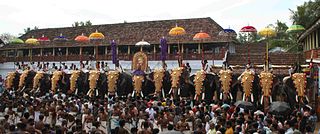
Sree Poornathrayesa temple is a Hindu temple situated in Thrippunithura, Kochi, the capital of the former Kingdom of Cochin, Kerala, India. The temple is considered among the greatest temples in Kerala and was the first among eight royal temples of the erstwhile Kingdom of Cochin. The presiding deity is Vishnu as Santhanagopala Murthy or Poornathrayeesa. He was the national deity of Cochin and protector guardian of Tripunithura. Poornathrayeesa is known for his love of elephants. Hence more than 40 elephants participate in his Vrishchikotsavam.
The Keralas or Udra Keralas were a royal dynasty mentioned in Sanskrit epics of ancient India. In the Mahabharata, the Keralian empire took part in the Kurukshetra War by feeding both armies. According to the Puranas, the navigators and survivors of the Yadavas of Dwaraka also settled in Kerala later. Some remnants of the Naga culture are also found here.
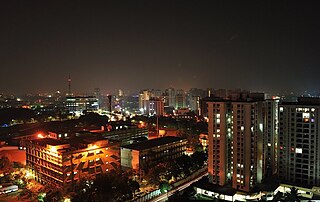
Thrikkakara is a region in the city of Kochi, as well as a municipality in Ernakulam District in the Indian state of Kerala, India in the Ernakulam district of Kerala, India. It is the location of the district headquarters, and is located about 207 km (128.6 mi) north of the state capital Thiruvananthapuram. Thrikkakara is part of the Kochi metropolitan area and is located 6.6 km (4.1 mi) east of the Kochi city centre. As per the 2011 Indian census, Thrikkakara has a population of 77,319 people, and a population density of 2,760/km2 (7,100/sq mi).

The Vilwadrinatha Temple is a Hindu temple in Thiruvilwamala, a town in the city of Thrissur, Kerala, India. The principal deities are Rama, the seventh incarnation of the god Vishnu, and his brother, Lakshmana. It figures among the Abhimana Kshetrams in Vaishnavite traditions. This is one of the four major Rama temples in Kerala — the other three are in Thriprayar, Kadavallur, and Thiruvangad. The temple houses an idol of Lakshmana, which is rare in India. Vilwadrinatha Temple is located in the centre of the community of Thiruvilwamala, atop a 100-foot-high hillock. Visible from the temple is Bharathappuzha, the second-largest river in Kerala, which flows past the temple's northern side from around 3 kilometres away.
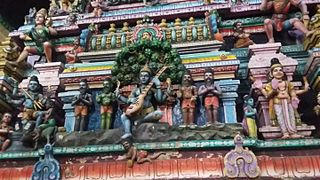
Ravishwarar Temple is a Hindu temple in Chennai, India. Built during the Chola period, the temple is dedicated to Shiva. It is located at Murthy Iyengar Street in the northern neighbourhood of Vyasarpadi.

The Sreevallabha Temple is an orthodox Hindu temple dedicated to Sreevallabha, a form of Vishnu. It is located in the city of Thiruvalla, India.

An onavillu is a simple, short, bow-shaped musical instrument. Its name may come from Onam, a festival in Kerala where the instrument is used in dances, and villu, which means 'bow' in Malayalam. Although still regularly used in rural art forms, use of the onavillu is on the decline.

Ulagalandha Perumal Temple is a temple dedicated to Vishnu located in Kanchipuram, Tamil Nadu, India. Constructed in the Dravidian style of architecture, the temple is glorified in the Naalayira Divya Prabandham, the early medieval Tamil canon of the Alvar saints from the 6th through 9th centuries CE. It is one of the 108 Divya Desams dedicated to Vishnu, who is worshipped as Ulagalantha Perumal, and his consort Lakshmi as Amuthavalli. The temple is believed to have been built by the Pallavas, with later contributions from the medieval Cholas, Vijayanagara kings, and Madurai Nayaks.
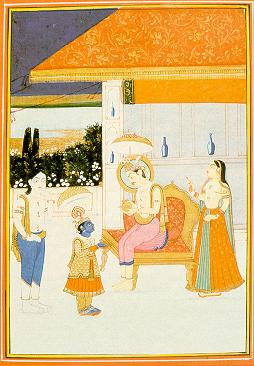
Balipratipada, also called as Bali-Padyami, Padva, Virapratipada or Dyutapratipada, is the fourth day of Diwali, the Hindu festival of lights. It is celebrated in honour of the notional return of the daitya-king Bali (Mahabali) to earth. Balipratipada falls in the Gregorian calendar months of October or November. It is the first day of the Hindu month of Kartika and is the first day of its bright lunar fortnight. In many parts of India such as Gujarat and Rajasthan, it is the regional traditional New Year Day in Vikram Samvat and also called the Bestu Varas or Varsha Pratipada. This is the half amongst the three and a half Muhūrtas in a year.
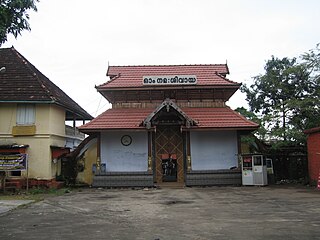
Ernakulam Shiva Temple, also known as Ernakulathappan Temple, is one of the major temples of Kerala, located in heart of Ernakulam, Kochi,Kerala, India. The temple, dedicated to Lord Shiva, is considered as the city temple, with the presiding deity as the protector of the city, as per local Hindu faiths and traditions. As per the common practice in Kerala, the deity is reverently called Ernakulathappan, which means Lord of Ernakulam. The temple is located within the Durbar Hall Ground. The temple history itself has deep association with history of the city and was one of the 7 royal temples of Kochi Maharajas. The temple is now under administration of Cochin Devaswam Board. The temple in its current form was built under active patronage of Diwan Sri Edakkunni Sankara Warrier in year 1846 and raised it level of a Royal temple in the Kochi Kingdom. The temple is built on 1-acre (4,000 m2) land. The temple is one of the major Shiva temples in Kerala counted along with the Ettumanoor Mahadevar Temple, Kaduthruthy Mahadeva Temple, Vaikom Temple, Chengannur Mahadeva Temple, Vadakkunathan temple, and Sreekanteswaram Mahadeva Temple, Thiruvananthapuram.
Mithranandapuram Vamanamoorthy Temple is a Hindu temple situated in Cherpu of Thrissur District of Kerala, India. According to the legends, the idol worshiped here is more than 1,500 years old.

Kazheesirama Vinnagaram or Tadalan Kovil or Tiruvikrama (trivikara) Perumal Temple is a temple dedicated to Vishnu located in Sirkazhi, Tamil Nadu, India. Constructed in the Dravidian style of architecture, the temple is glorified in the Nalayira Divya Prabandham, the early medieval Tamil canon of the Alvar saints from the 6th–9th centuries CE. It is one of the 108 Divya Desam dedicated to Vishnu, who is worshipped as Trivikrama and his consort Lakshmi as Loganayagi. The temple is believed to have been built by Cholas, with later contributions from Medieval Cholas, Vijayanagara kings, and Madurai Nayaks.

Ulagalantha Perumal Temple or Trivikrama Temple is a Hindu temple dedicated to Vishnu located in Tirukkoyilur, Tamil Nadu, India. Constructed in the Dravidian style of architecture, the temple is glorified in the Naalayira Divya Prabandham, the early medieval Tamil canon of the Alvar saints from the 6th–9th centuries CE. It is one of the 108 Divya Desams dedicated to Vishnu, who is worshipped as Ulagalantha Perumal and his consort Lakshmi as Poongothai. The temple is believed to have been built by the Medieval Cholas, with later contributions from Vijayanagara kings and Madurai Nayaks. The temple covers an area of 5 acres (20,000 m2) and has a temple tower that is the third tallest in Tamil Nadu, measuring 192 ft (59 m) in height.
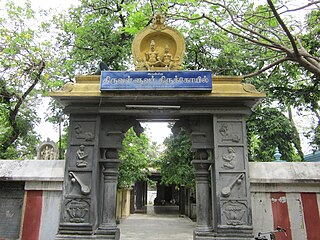
The Ekambareswarar–Kamakshi Temple, commonly known as the Thiruvalluvar Temple, is a Hindu temple dedicated to the poet-saint Valluvar in the neighborhood of Mylapore in Chennai, India. The shrine is located within the Ekambareswarar temple complex. Believed to have been constructed in the early 16th century, the temple was extensively renovated in the 1970s. Traditionally believed to be the birthplace of Saint Valluvar, the temple is the oldest ever built to Valluvar. The temple also serves as the venue for meetings of Tamil language enthusiasts and conducting Kural classes. While many consider the temple as the birthplace of Valluvar, some additionally consider it as his samadhi.

Velleeswarar Temple is a Hindu temple in Mylapore, Chennai, Tamil nadu, India. The presiding deity is Shiva as Velleeswarar. This mid-sized temple, spread over 2 acres is one amongst the Seven Shiva Temples of Mylapore. It is situated at South Mada Street, closer to Kapaleeswarar Temple.

Vamaneeswarar Temple is a Hindu temple dedicated to the deity Shiva, located in Thirumanikuzhi, a village in Cuddalore district in the South Indian state of Tamil Nadu. Shiva is worshiped as Vamaneeswarar, and is represented by the lingam. His consort Parvati is depicted as Manonmani Amman. The temple is located on the Chennai - Villupuram highway on the banks of Kedilam river. The presiding deity is revered in the 7th century Tamil Saiva canonical work, the Tevaram, written by Tamil saint poets known as the nayanmars and classified as Paadal Petra Sthalam.

Parumala Valiya Panayannarkavu Devi Temple is an ancient Hindu temple dedicated to Sri Badrakali and Lord Shiva, situated on the banks of the Pampa river at Parumala of Pathanamthitta District in Kerala state in India. The Panaynararkavu Temple is one of the three most important Bhadrakali temples in Kerala. Thirumandhamkunnu Temple in Malabar, Kodungallur Temple in Cochin and Panayannarkavu Temple in Travancore is almost equally important. References to this temple are found in Aithihyamala of Kottarathil Sankunni and Unnuneeli Sandesam, the classics of Malayalam Literature. According to folklore, sage Parashurama has installed the idol of Lord Shiva and devi idol installed by sage Durvasa and Narada in the Treta Yuga. The temple is a part of the 108 famous Shiva temples in Kerala.






























